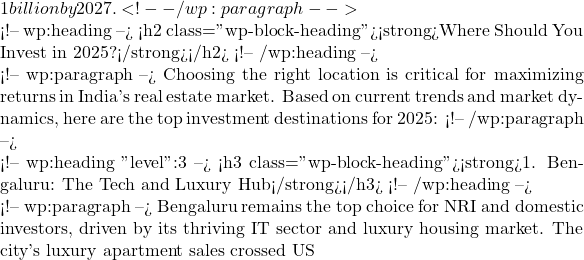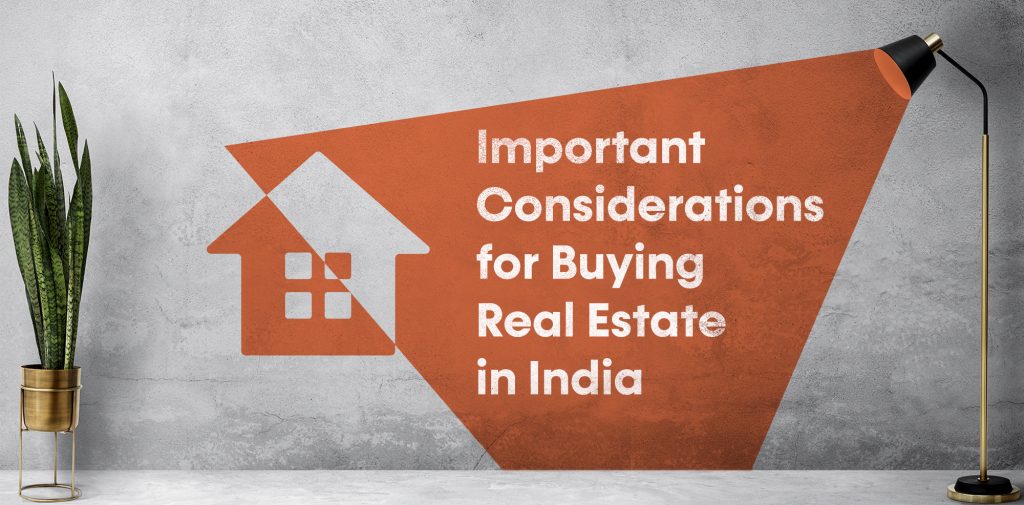The Indian real estate market is poised for a transformative year in 2025, driven by rapid urbanization, technological advancements, policy reforms, and shifting consumer preferences. With the sector projected to contribute 13% to India’s GDP by 2025 and reach a market size of US 1.3 billion, the sector is witnessing unprecedented momentum. For investors, 2025 presents a unique window to capitalize on this growth by focusing on the right trends and locations.
1.3 billion, the sector is witnessing unprecedented momentum. For investors, 2025 presents a unique window to capitalize on this growth by focusing on the right trends and locations.
Top Real Estate Trends Shaping India in 2025
1. Rise of Luxury and Ultra-Luxury Housing
The luxury housing market is booming, driven by high-net-worth individuals (HNIs) and NRIs seeking premium properties with world-class amenities. In Q1 2025, sales of high-end homes priced above US![]() 117.05 million in annual sales, reflecting a shift toward aspirational and strategic investments.
117.05 million in annual sales, reflecting a shift toward aspirational and strategic investments.
Key Features of Luxury Homes in 2025:
- Smart Technology: Automated systems, IoT-enabled devices, and enhanced security features are standard in luxury properties.
- Sustainability: Energy-efficient designs, solar panels, and green certifications are increasingly common.
- Lifestyle Amenities: Private pools, wellness centers, and proximity to nature are top priorities for affluent buyers.
Investment Tip: Focus on prime locations in Mumbai, Delhi, and Bengaluru, where luxury properties offer high capital appreciation and rental yields.
2. Growth of Affordable Housing in Tier-II and Tier-III Cities
While luxury housing thrives, affordable housing in suburban areas and Tier-II/III cities like Ahmedabad, Jaipur, and Chandigarh is gaining traction. Government initiatives like the Smart Cities Mission and AMRUT have transformed these cities into residential hubs with improved infrastructure. The rise of remote work has further fueled demand for spacious homes at lower prices in these regions.
Why Invest in Tier-II/III Cities?
- Lower Entry Costs: Properties in these cities are more affordable than in metros, offering higher returns on investment.
- Growing Job Opportunities: The presence of MNCs and startups in cities like Pune and Hyderabad is driving population growth.
- Rental Demand: Young professionals and students are boosting the rental market in these areas.
Investment Tip: Look for RERA-registered projects in emerging cities to ensure transparency and timely delivery.
3. Surge in Commercial Real Estate
Commercial real estate is experiencing a revival, with a projected CAGR of 6-8% in 2025, driven by demand from IT, financial services, and e-commerce sectors. Flexible office spaces and coworking hubs are in high demand due to hybrid work models, particularly in tech-centric cities like Bengaluru, Hyderabad, and Pune.
Key Commercial Trends:
- Shop-Cum-Offices (SCOs): Gurugram is a hotspot for SCOs, offering longer leases and consistent cash flow.
- Warehousing: The e-commerce boom is driving a 10-12% CAGR in warehousing, with demand for logistics centers soaring.
- Sustainability: Developers are incorporating energy-efficient designs and green certifications in commercial projects.
Investment Tip: Fractional ownership in commercial properties offers high rental yields (8-12%) and lower risk, making it ideal for retail investors.
4. Emergence of Alternative Asset Classes
Beyond traditional residential and commercial properties, alternative asset classes are reshaping the real estate landscape in 2025:
- Data Centers: With a projected CAGR of 25% through 2025, data centers are in high demand due to policies like Digital India and the rise of cloud computing. Chennai, Hyderabad, and Mumbai are emerging as key hubs.
- Co-Living Spaces: Fueled by millennials and young professionals, co-living spaces are expected to grow by 17% annually, offering affordable, community-oriented living.
- Senior Housing: India’s aging population is driving demand for tailored communities with healthcare and social engagement facilities.
Investment Tip: Diversify your portfolio by investing in REITs that include alternative assets for stable returns and lower risk.
5. PropTech Revolution
Property technology (PropTech) is transforming the real estate sector, making transactions more efficient and transparent. In 2025, PropTech innovations include:
- AI-Driven Analytics: Tools for property pricing and market predictions reduce investment risks.
- Virtual Reality (VR) Tours: Immersive property tours save time and attract NRI buyers.
- Fractional Ownership Platforms: Tokenization enables smaller investments in high-value assets.
Investment Tip: Partner with developers leveraging PropTech to ensure transparency and access to high-quality projects.
6. Second Homes and Vacation Properties
Post-pandemic, the demand for second homes in vacation-friendly destinations like Kerala, Uttarakhand, and Himachal Pradesh has surged. These properties serve as retreats and short-term rental investments, offering rental yields of 8-12%.
Why Invest in Second Homes?
- High Rental Yields: Tourist-heavy locations attract consistent rental income.
- Capital Appreciation: Improved infrastructure in these areas boosts property values.
- Lifestyle Appeal: Buyers prioritize wellness-oriented designs and proximity to nature.
Investment Tip: Focus on branded residences and resorts, projected to reach US 117.05 million in FY25, with demand for spacious, ultra-premium homes soaring.
117.05 million in FY25, with demand for spacious, ultra-premium homes soaring.
Why Invest?
- Strong rental demand from young professionals and expats.
- Upcoming metro expansions and infrastructure projects enhance connectivity.
- High capital appreciation in areas like Whitefield and Sarjapur Road.
Best Asset Classes: Luxury apartments, commercial SCOs, and data centers.
Also Read - Posh areas in Bangalore
2. Mumbai: The Financial and Luxury Capital
Mumbai’s real estate market is synonymous with luxury and high returns. The city leads in branded residences and commercial investments, with REITs attracting over ₹8,000 crores annually by 2025.
Why Invest?
- High demand for premium properties in areas like Worli and Bandra.
- Strong rental yields in commercial hubs like BKC.
- Infrastructure projects like the Mumbai Trans Harbour Link boost property values.
Best Asset Classes: Luxury homes, commercial properties, and fractional ownership.
Also Read - Posh areas in Mumbai
3. Pune: The Emerging IT Hotspot
Pune’s real estate market is transitioning rapidly, with metro expansions and new expressways making suburbs like Hinjewadi and Baner investment hotspots. The city’s young population (42% aged 25-40) drives demand for residential and co-living spaces.
Why Invest?
- Affordable entry points compared to Mumbai and Bengaluru.
- Growing IT and startup ecosystem fuels commercial demand.
- High rental yields in suburban areas.
Best Asset Classes: Residential properties, coworking spaces, and warehousing.
Also Read - Posh Areas in Pune
4. Hyderabad: The Data Center and Commercial Hub
Hyderabad is emerging as a key destination for data centers and commercial real estate, with a projected CAGR of 6-8% in 2025. The city’s affordability and infrastructure make it attractive for residential investments as well.
Why Invest?
- Strong demand for office spaces in HITEC City.
- Growing rental market for co-living and affordable housing.
- Government support for tech-driven industries.
Best Asset Classes: Data centers, commercial properties, and affordable housing.
Also Read - Posh Areas in Hyderabad
5. Tier-II Cities: Ahmedabad, Jaipur, and Chandigarh
Tier-II cities are becoming viable investment destinations due to lower costs, improved infrastructure, and rising job opportunities. Ahmedabad and Jaipur are particularly attractive for affordable housing and commercial SCOs.
Why Invest?
- High ROI potential due to lower property prices.
- Government-backed infrastructure projects like Smart Cities Mission.
- Growing demand for rental properties from young professionals.
Best Asset Classes: Affordable housing, SCOs, and co-living spaces.
Challenges and Risks to Consider
While the Indian real estate market offers immense opportunities, investors must navigate potential challenges:
- Inflation and Interest Rates: Rising lending rates could impact affordability and demand.
- Regulatory Delays: Project approvals and clearances can cause delays.
- Market Volatility: Economic downturns or geopolitical factors may affect returns.
- Property Title Issues: Due diligence is critical to avoid legal disputes.
Mitigation Strategies:
- Invest in RERA-registered projects for transparency.
- Diversify across asset classes and locations to spread risk.
- Leverage PropTech tools for market analysis and due diligence.
Also Read - Best cities to invest in Real Estate in India 2025
Conclusion: Seize the Opportunity in 2025
India’s real estate market in 2025 is a dynamic blend of innovation, growth, and opportunity. From luxury housing in Bengaluru and Mumbai to affordable homes in Tier-II cities, the sector offers something for every investor. Emerging asset classes like data centers, co-living spaces, and senior housing provide diversification, while PropTech and policy reforms enhance transparency and accessibility.
To maximize returns, focus on high-growth cities like Bengaluru, Mumbai, Pune, Hyderabad, and emerging Tier-II hubs. Prioritize RERA-registered projects, leverage fractional ownership for commercial assets, and stay informed about market trends through PropTech tools. With strategic planning and informed decision-making, 2025 could be your year to build wealth through Indian real estate. Now, very soon, Lets Rentz is launching its Buy and Sell services also in Try City and Delhi NCR. If you want to buy or invest in a property washout brokerage, you can visit Lets Rentz.



